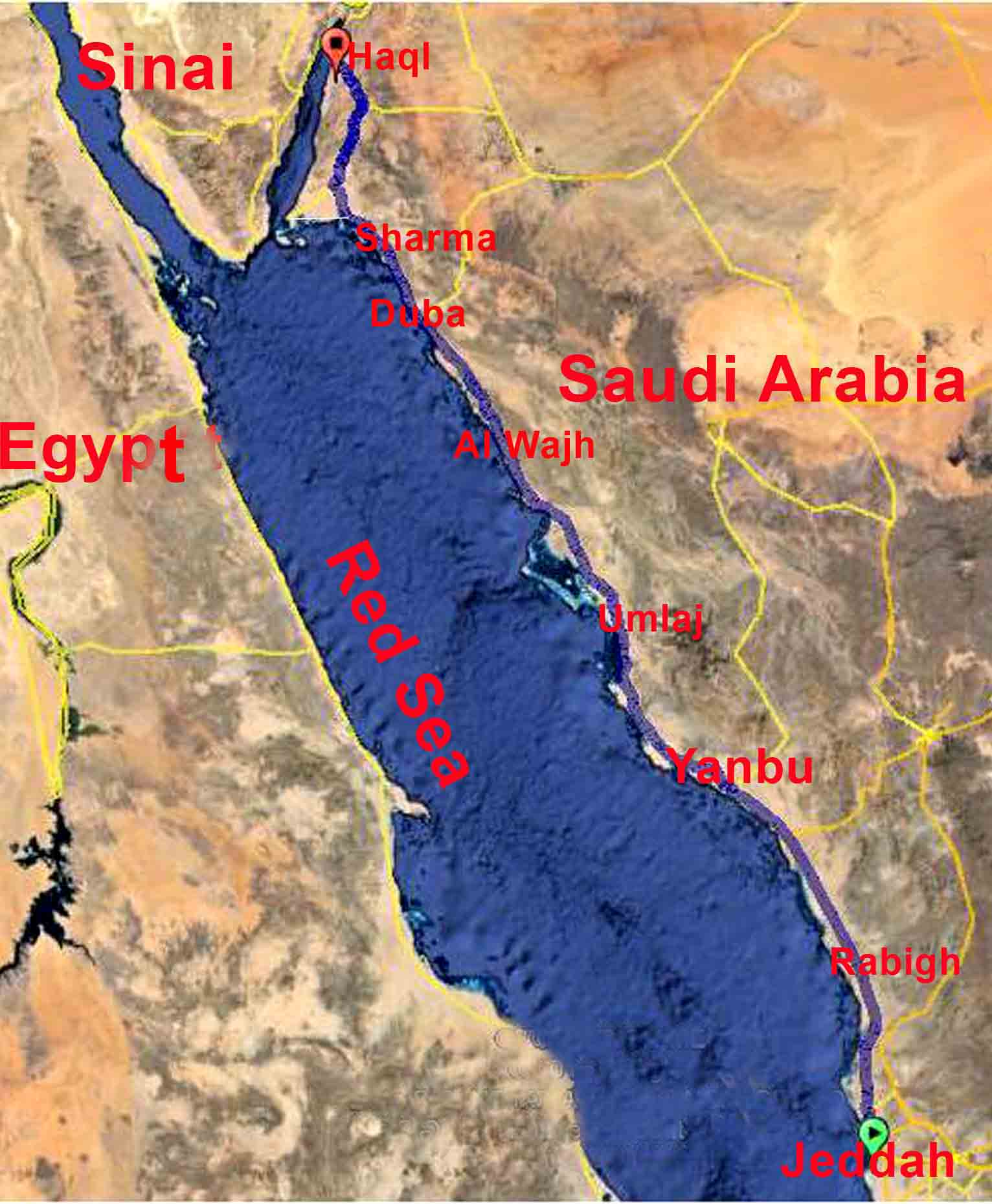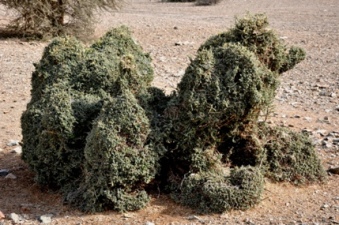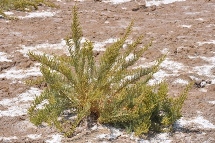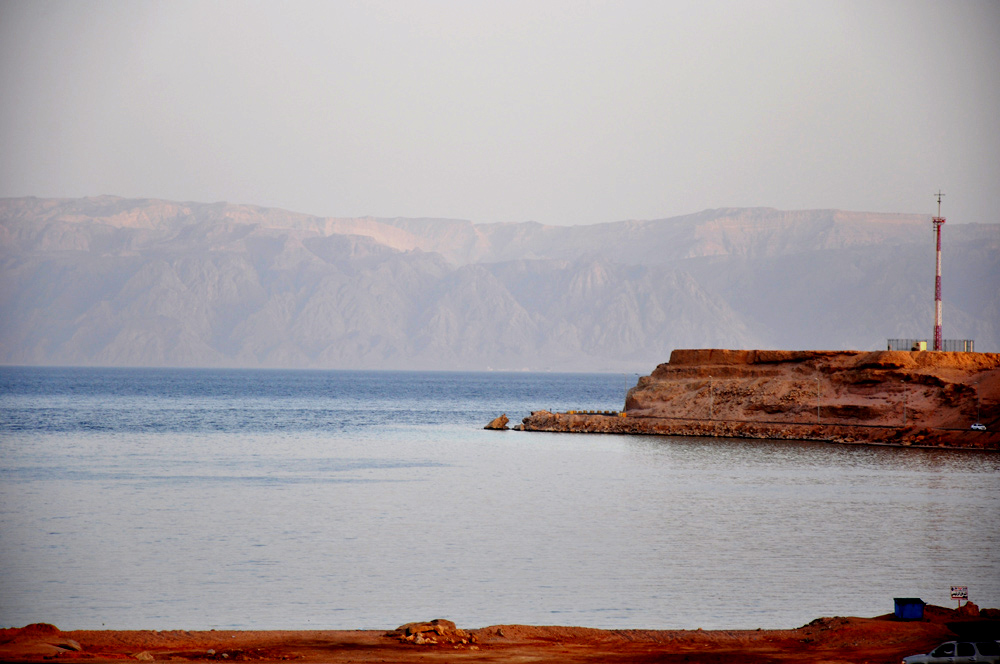Northern Tihama

Northern Tihama, a narrow strip of undulated coastal zone situated between Red Sea on its western side and a chain of mountains (Hijaz) on its entire eastern side. It is a 1080 km long sandy and silt area extending from Jeddah in the south to Haql town in the north. The strip is more or less at sea level in the south or slightly elevated towards east as a result of the silt coming from the Hijaz Mountains. The plains along the eastern side of the coastal zone is wide in the southern parts (between Jeddah and Yanbu) and narrow in the northern sector, north of Yanbu. Tihama is virtually absent near Haql area where its sea shore merges with the foothills of escarpments. Shore line is somewhat undulate margined with some creeks penetrating into the land. Rainfall is erratic along the coast, occurring mainly between October and February. Less than 20 mm rainfall is recorded in the Jeddah and Yanbu stations. Maximum average temperature ranges between 25 and 33 0C and humidity ranges between 50-75%. Unlike the southern Tihama region, the mangrove population is not dense and continuous in the entire coastal marshy land except in some of the creeks near Thuwal, Yanbu and in some islands off Al-Wajh where dense stands of healthy Avicennia marina could be seen. The northern limit of the distribution of Avicennia marina along the Red Coast in Saudi Arbia appears to be near Sharm Zubeir, off the coast between Al-Sourah and Sharmaa. Rhizophora mucronata, the only other mangrove reported along Red Sea coast is also found in a few locations north of Jeddah (Umm Ruma Island, Dugm Sabq, Gama’an Island, Shibara Island, etc). However, its main populations are found in Al Wajh Bank, an Archipelago comprised of about 50 islands located south west of Al Wajh.
Unlike the southern Red Sea Islands, northern Red Sea Islands (Al Wajh Bank) are devoid of any dense vegetation. Majority of these islands are sandy while others are rocky with small hillocks of 5m high or less. Vegetation is almost nil in most of the islands except in a few where salt bushes such as Arthrocnemum macrostachyum, Halocnemum strobilaceum, Zygophyllum spp. etc dominate in patches.
The plains of Northern Tihama are composed of stones and sand with differing soil depths. Vegetation between Jeddah and Yanbu is more or less similar to the that of the plains of southern Tihama. The most dominant among them is the widely spaced Acacia tortilis-Maerua crassifolia association. However, M. crassifolia is in a highly degraded state, mostly seen as heavily grazed and cushion-formed. Other Capparaceae species dominant in the sand dunes and stony plains of southern Tihama, such as Dipterygium glaucum, Cadaba glandulosa are less frequent north of Jeddah. Similarly Commiphora spp., dominant in the foothills of southern Tihama, is almost nil in the northern Tihama. Most of the areas during summer are dry and barren. Dominant species of the plains and foot hills are the scattered A. tortilis intermixed with A. ehrenbergiana. Abutilon pannosum, Lycium shawii, Ochradenus baccatus, etc. dominate in shallow silt depressions and Leptadenia pyrtotechnica and Rhazya stricta dominate in sandy hummocks. Common grasses in these areas are Panicum turgidum, Pennisetum divisum and occasionally Lasiurus scindicus and Aristida spp. Coastal areas are mainly dominated by salt bushes composed of chenopods and Zygophyllum spp. Limonium axillare, Arthrocnemum macrostachyum, Halopeplis perfoliata and Zygophyllum coccineum are the most dominant along the northern sabkhas. In general, L. axillare grow in low lying areas or in localized depressions while Z. coccineum dominate in areas covered by coral rocks or coral sands. The areas north of Jeddah the coastal zone is covered by white coral sand supporting dense stands of Suaeda monoica and Anabasis setifera. On the eastern side where the soil is less saline, the vegetation is dominated by Acacia ehrenbergiana, Anastatica heirochuntica, Senna italica and Hyparrhenia hirta.
Sabkhas of the coastal areas of Thuwal are densely vegetated with salt bushes. It supports Zygophyllum coccineum and Aeluropus lagopoides along with Desmostachya bipinnata, Indigofera oblongifolia and Astragalus spinosa in some locations. Sands overlain the crusty salt substratum support a number of annuals such as Sonchus oleraceus, Launaea mucronata, etc.
Trees are generally few in the entire Tihama area. Among the large trees, Acacia raddiana, A. johnwoodii, Capparis decidua, Maerua crassifolia and Hyphaene thebaica, are prominent. Further north, the coastal zones near Rabigh and south of Yanbu are devoid of any appreciable level of vegetation due to the development of industries and corniches or occasionally with secondary vegetation dominated by Aeluropus lagopoides, Cressa cretica, Halopeplis perfoliata and Zygophyllum coccineum. At places where they form into dense stands sand accumulates at the base of these shrublets and provide habitats for other mesophytes such as Fagonia indica, Glinus lotoides, Lotus corniculatus, Picris cyanocarpa, etc. Ruderals and the common invasive species, Prosopis juliflora also dominate around new settlements and along road sides.
Coastal lines of Yanbu are with several creeks, most of which provide shelters for the growth of Avicennia marina. Sea in this area is very shallow. Cymodocea rotundata, the wide leaved sea grass occurs in such waters.
The coastal zone is bounded on the east by salty flats or small dunes of coral sand. In some places north of Yanbu industrial city, coastal areas are often enclosed by coral rock and drained sand gullies. Saline coasts are dominated by Arthrocnemum macrostachyum, Tamarix aucheriana, Suaeda vermiculata, Sporobolus spicatus, while the sandy soil towards the interiors are dominated by Acacia ehrenbergiana and A. tortilis associated with Taverniaria spartea. During spring, most of the herbaceous flora of the plains and foothills near Wajh and Umlaj are mostly seen along the drainage channels, alluvial plains and other silt filled depressions. Ravines are dominated by Gymnocarpos decander, Ochradenus baccatus, Zilla spinosa and Aerva javanica. Another striking species in the area is the Retama raetam, usually found in plains close to foothills.
Coastal areas of Duba is dominated by Aeluropus lagopoides, Juncus rigidus and Nitraria retusa. In some places it is seen in close associations with Haloxylon salicornicum, Seidletzia rosmarinus, Suaeda monoica or Zygophyllum coccineum. Open plains, not far away from the coastal zone, the branched palm tree, Hyphaene thebaica is seen intermixed with Acacia ehrenbergiana.
The extreme northern side near Haql, Tihama is narrow with a rocky terrain. In some places the escarpment is seen very close to the sea shore. Haloxylon salicornicum dominate in these areas along with Acacia tortilis, Fagonia mollis, Capparis decidua and Stipagrostis plumosa. Small water channels and runnels originate along the slopes and reach the sea. During rainy season, silt accumulates in small ditches along the slopes and provide habitats for a diverse herbaceous flora comprised of Aizoon canariense, Arnebia hispidissima, Bassia muricata, Blepharis ciliaris, Caylusea hexagyna, Cucumis prophetarum, Diplotaxis harra, Fagonia bruguieri, Launaea capitata, Trigonella hamosa, Zilla spinosa and Zygophyllum simplex (Tetraena simplex).



Flora of Northern Tihama
Acanthaceae
Blepharis ciliaris
Justicia flava
Aizoaceae
Aizoon canariense
Mesembryanthemum nodiflorum
Amaranthaceae
Aerva javanica
Amaranthus graecizans
Amaranthus hybridus
Amaranthus viridis
Anabasis setifera
Arthrocnemum macrostachyum
Atriplex farinosa
Bassia muricata
Bienertia cycloptera
Chenopodium glaucum
Chenopodium murale
Digera muricata
Halocnemum strobilaceum
Halopeplis perfoliata
Haloxylon salicornicum
Salsola imbricata
Salsola lachnantha
Salsola spinescens
Salsola volkensii
Seidlitzia rosmarinus
Suaeda aegyptiaca
Suaeda monoica
Suaeda vermiculata
Amaryllidaceae
Pancratium maximum
Apiaceae
Anisosciadium lanatum
Deverra triradiata
Apocynaceae
Calotropis procera
Cynanchum acutum
Leptadenia pyrotechnica
Odontanthera radians
Pergularia daemia
Pergularia tomentosa
Rhazya stricta
Aracaceae
Hyphaene thebaica
Phoenix dactylifera
Asparagaceae
Asparagus falcatus
Asphodelaceae
Asphodelus fistulosus
Asteraceae
Asteriscus hierochunticus
Atractylis mernephthae
Centaurea pseudosinaica
Centaurea schimperi
Centaurea scoparia
Cotula sp.
Echinops erinaceus
Echinops erinaceus
Echinops polyceras
Echinops viscosus
Ifloga spicata
Iphiona scabra
Launaea capitata
Launaea intybacea
Launaea massauensis
Launaea mucronata
Launaea procumbens
Picris babylonica
Picris cynocarpa
Pluchea ovalis
Pulicaria guestii
Pulicaria jaubertii
Pulicaria undulata
Reichardia tingitana
Senecio flavus
Sonchus oleraceus
Boraginaceae
Arnebia hispidissima
Echium horridum
Gastrocotyle hispida
Heliotropium aegyptiacum
Heliotropium arbainense
Heliotropium bacciferum
Heliotropium curassavicum
Heliotropium europeam
Heliotropium rariflorum
Trichodesma africanum
Brassicaceae
Anastatica hierochuntica
Anastatitica heirochuntica
Diplotaxis acris
Diplotaxis harra
Diplotaxis harra
Eremobium aegyptiacum
Eremobium aegyptiacum s. lineare
Eremobium lineare
Erucaria hispanica
Farsetia aegyptia
Farsetia longisiliqua
Farsetia longisiliqua
Farsetia stylosa
Farsetia stylosa
Morettia parviflora
Morettia parviflora
Notoceras bicorne
Sisymbrium erysimoides
Zilla spinosa
Capparaceae
Cadaba farinosa
Cadaba glandulosa
Cadaba oblongifolia
Capparis decidua
Capparis sinaica
Cleome amblyocarpa
Cleome brachycarpa
Cleome glaucescens
Cleome noeana
Cleome viscosa
Dipterygium glaucum
Maerua crassifolia
Caryophyllaceae
Gymnocarpos decandrum
Gypsophila capillaris
Paronychia arabica
Polycarpaea repens
Polycarpaea robbairea
Pteranthus dichotomus
Sclerocephalus arabicus
Silene linearis
Spergula fallax
Convolvulaceae
Convolvulus fatmensis
Convolvulus glomeratus
Convolvulus hystrix
Convolvulus pilosellifolius
Cressa cretica
Cuscuta campestris
Cuscuta planiflora
Seddera latifolia
Cucurbitaceae
Citrullus colocynthis
Cucumis prophetarum
Cymodoceaceae
Cymodocea rotundata
Cyperaceae
Cyperus conglomeratus
Ephedraceae
Ephedra foliata
Ephedra aphylla
Euphorbiaceae
Andrachne telephioides
Chrozophora oblongifolia
Chrozophora tinctoria
Euphorbia cuneata
Euphorbia granulata
Euphorbia retusa
Gentianaceae
Centaurium spicatum
Geraniaceae
Erodium deserti
Erodium laciniatum
Erodium touchyanum
Monsonia nivea
Juncaceae
Juncus rigidus
Lamiaceae
Lavandula coronopifolia
Lavandula pubescens
Otostegia fruticosa
Salvia aegyptiaca
Salvia deserti
Salvia deserti
Teucrium leucocladum
Teucrium polium
Leguminosae
Acacia ehrenbergiana
Acacia gerrardii
Acacia hamulosa
Acacia johnwoodii
Acacia oerfota
Acacia origena
Acacia raddiana
Acacia tortilis
Astragalus fatmensis
Astragalus schimperi
Astragalus vogelii v. fatmensis
Crotalaria aegyptiaca
Indigofera coerulea
Indigofera oblongifolia
Indigofera spinosa
Lotus corniculatus
Prosopis juliflora
Psoralea plicata
Retama raetam
Senna alexandrina
Senna italica
Taverniaria spartea
Tephrosia nubica
Trigonella hamosa
Trigonella stellata
Loranthaceae
Plicosepalus curviflorus
Malvaceae
Abutilon pannosum
Abutilon pannosum
Abutilon sp.
Hibiscus micranthus
Malva parviflora
Malva verticillata
Subfamily-Grewioideae
Corchorus depressus
Corchorus olitorius
Grewia mollis
Grewia tembensis
Grewia tenax
Menispermaceae
Cocculus pendulus
Molluginaceae
Glinus lotoides
Gisekia pharnaceoides
Neuradaceae
Neurada procumbens
Nitrariaceae
Nitraria retusa
Nyctaginaceae
Boerhavia diffusa
Orobanchaceae
Cistanche phylepaea
Plantaginaceae
Kickxia pseudoscoparia
Plantaginaceae
Plantago amplexicaulis
Plantago ciliata
Plantago ovata
Plumbaginaceae
Limonium axillare
Poaceae
Aeluropus lagopoides
Aristida adscensionis
Cenchrus ciliaris
Centropodia forsskalei
Cymbopogon schoenanthus
Cynodon dactylon
Desmostachya bipinnata
Dichanthium annulatum
Enneapogon desvauxii
Eragrostis barrelieri
Hyparrhenia hirta
Lasiurus scindicus
Panicum turgidum
Paspalidium desertorum
Pennisetum divisum
Poa annua
Schismus barbatus
Sporobolus spicatus
Stipa capensis
Stipagrostis ciliata
Stipagrostis plumosa
Polygonaceae
Calligonum comosum
Rumex vesicarius
Resedaceae
Caylusea hexagyna
Ochradenus baccatus
Oligomeris linifolia
Reseda decursiva
Reseda sphenocleoides
Rhamnaceae
Ziziphus spina-christi
Rhizophoraceae
Rhizophora mucronata
Salvadoraceae
Salvadora persica
Scrophulariaceae
Kickxia aegyptiaca
Solanaceae
Datura innoxia
Lycium shawii
Solanum glabratum v. sepicula
Solanum incanum
Solanum sepicula
Tamaricaceae
Tamarix aucheriana
Tamarix nilotica
Urticaceae
Forsskaolea tenacissima
Verbenaceae
Avicennia marina
Xanthorrhoeaceae
Asphodelus fistulosus
Zygophyllaceae
Fagonia bruguieri
Fagonia glutinosa
Fagonia indica
Fagonia mollis
Fagonia schweinfurthii
Fagonia tristis
Seetzenia lanata
Tribulus pentandrus
Tribulus terrestris
Zygophyllum album
Zygophyllum coccineum
Zygophyllum fabago
Zygophyllum hamiense var. qatarense
Zygophyllum simplex

A view of the Northern Tihama. Haql, near Jordan border
A view of Gulf of Aqaba from Haql (Northern Saudi Arabia) with Mount Sinai of Egypt in the background.